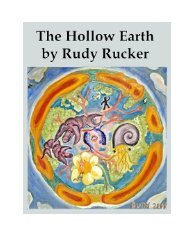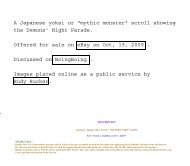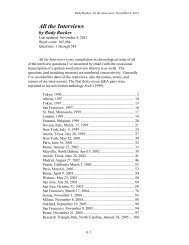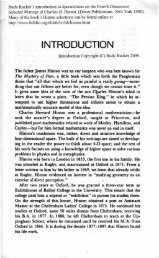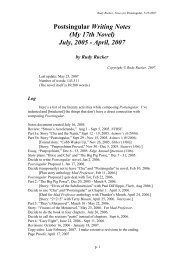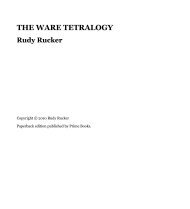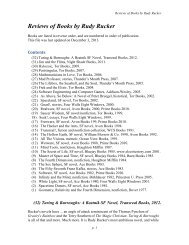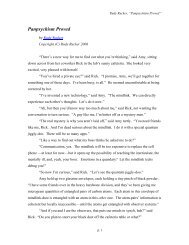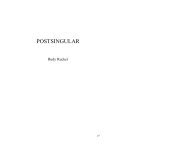Notes for the Lifebox, the Seashell, and the Soul - Rudy Rucker
Notes for the Lifebox, the Seashell, and the Soul - Rudy Rucker
Notes for the Lifebox, the Seashell, and the Soul - Rudy Rucker
Create successful ePaper yourself
Turn your PDF publications into a flip-book with our unique Google optimized e-Paper software.
<strong>Notes</strong> <strong>for</strong> The <strong>Lifebox</strong>, <strong>the</strong> <strong>Seashell</strong>, <strong>and</strong> <strong>the</strong> <strong>Soul</strong>, by <strong>Rudy</strong> <strong>Rucker</strong><br />
Figure: The StarWars Rule.<br />
Starting from a r<strong>and</strong>om bath of pixels, StarWars settles into pattern resembling an<br />
aerial view of a busy factory. In <strong>the</strong> center we have a glob shooting out a regular stream of<br />
gliders which disintegrate when <strong>the</strong>y hit <strong>the</strong> little block to its right. The more regularlooking<br />
horizontal <strong>and</strong> vertical lines are also streams of gliders. Small sparks flicker around<br />
<strong>the</strong> edges of <strong>the</strong> globs. Now <strong>and</strong> <strong>the</strong>n a rogue glider crashes into a glob <strong>and</strong> kicks up a<br />
prolonged cascade of reactions.<br />
The StarWars rule has four states, which we think of as being a ready state, a firing<br />
state, <strong>and</strong> two distinct two resting states. The update rule is similar to that of Brian’s Brain,<br />
with two differences: it’s possible <strong>for</strong> a cell to continue firing <strong>for</strong> more than one update, <strong>and</strong><br />
<strong>the</strong> cells rest <strong>for</strong> two updates instead of one. The grids are made up of firing cells that<br />
stimulate each o<strong>the</strong>r to continue firing, while <strong>the</strong> little gliders are made of firing cells trailed<br />
by resting cells.<br />
StarWars worlds smaller than 500 by 500 pixels become periodic in about 40,000<br />
generations, but I’m not sure if <strong>the</strong> larger worlds begin repeating <strong>the</strong>mselves within any<br />
reasonable time frame. At <strong>the</strong> very least <strong>the</strong> rule is class two, but my feeling is that, given<br />
p. 85



